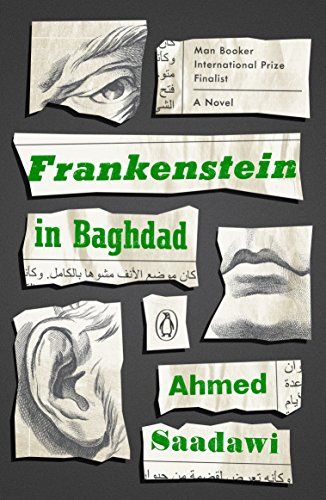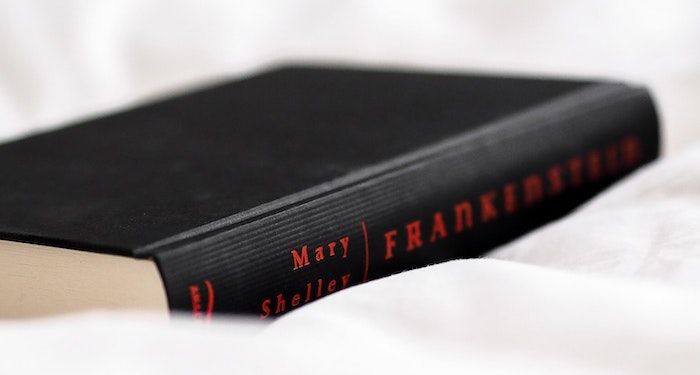
Reconstructing FRANKENSTEIN: Reviving Shelley’s Monster
As Autumn shuffles in, I find myself returning to Mary Shelley’s Frankenstein again. A classic meditation on the existence of monsters, I find the bitter chill of the early portion’s Arctic exploration a strange comfort, not just because it’s great reading material for when you’re snuggled up in contrasting cosyness. For all the following misadventures in science that take place in the story, I think the yo-yoing enthusiasm and awe that comes across so clearly in Walton’s letters is my favourite part because of the way it lays the foundation of the narrative’s strongest idea: perspective.
Much like the eponymous modern Prometheus, the book is a hodgepodge of different points of view that have been stitched together to form an unreliable, endlessly fascinating behemoth of a story that only emphasises the novel’s penchant for gothic misdirection, uncertainty, and a consistently liminal sense of reality. As Walton fawns over Victor and whines to his sister about how boring his once-in-a-lifetime nautical journey is, you begin to wonder about the types of stories are locked away inside Victor’s later, narrow-minded take on the situation. This variety of narrative avenues, and the way the self-absorption of each character lends itself to plenty of unreliability to explore, provides a perfect opportunity for new stories to emerge; new stories that challenge the themes of the original, or shine a light on the unspoken angles that were obscured by Victor’s constant egotism.
While I have yet to discover a novel about Walton (I’m envisaging a quiet, pining romance story between him and the scientist he drags out of the sea) or Justine (the Black maid who is framed for a murder committed by the Creature), recontextualising the canon is a vital exercise in creative deconstruction. It asks us to consider the power of perspective, destabilising dominant viewpoints, and rather than rebuild it crafts a new whole from each fragmented piece. The following texts offer a fresh look at the world of Frankenstein, and demonstrates that the themes and characters are still living, breathing, relevant things, resurrecting the original from antiquity and reframing the familiar tale.
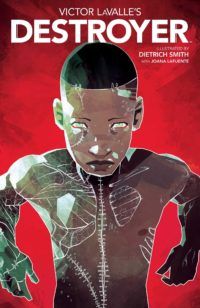
Destroyer by Victor LaValle
This graphic novel is set in 2017, when the Frankenstein myth is a reality buried underneath government conspiracies and banished from the realm of practical, accepted science. However, the Creature still stalks society, seeking vengeance. Eventually, he crosses paths with Dr Josephine Baker, a brilliant scientist who uses reconstructive technology to revive her son, who was murdered by the police. Through examining all three of the characters’ perspectives on ideas like creation and autonomy, the story explores themes of human identity, responsibility, and parenthood. Dr Baker is a fantastic protagonist, as her determination to defy the brutality she suffers remains compelling even as she begins to stagger into morally questionable plans, and her relationships with her son and ex-husband are complex. Packed with stunning art, this book develops the motivations of the original’s protagonist, asking who has the privilege to create and if such an act is ever a selfless thing. And there’s a mech in it!
Trigger warnings: police brutality, body horror
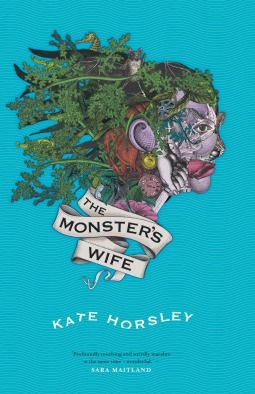
The Monster’s Wife by Kate Horsley
Atmospheric and isolating, The Monster’s Wife provides you with the perspective of a character from Shelley’s original text who remained silent, objectified. Now, we get to follow her down the path of canon divergence, and dissects the position of women in horror along the way. Oona is a bored, restless girl living on a remote Scottish island on which Doctor Frankenstein attempts to hide from his creation partway through the original novel. What begins as a slow-burn story of dramatic irony soon careens into an obscure romance of sorts. The novel puts a new spin on the story of Frankenstein, portraying him as both the victim and manipulator of his own situation, suitably Byronic and dangerous. It also explores the suppression of women in the victorian era, as well as contesting the belief that the creature would be disregarded for his appearance, ultimately concluding that both men were cruel by choice, due to their ego and misconceptions of the world rather than as a result of infrequent maltreatment.
Trigger warnings: sexual assault, body horror
Frankenstein in Baghdad by Ahmed Saadawi
Seizing on the theme of reconstruction and the power of recollection (both in terms of remembering the past and gathering that which has been destroyed back together), this novel explores the concept of creation as a radical act of rebellion against extermination. In connecting the tissues of war victims, flesh comes back to life and demands flesh too, sparking a bleak tale about identity, respect, and revenge. Unlike in Shelley’s original, this isn’t about someone attempting to overcome death for the purposes of challenging God or nature, but overcoming death in order to challenge the oppressive systems that force innocent bystanders to succumb to it for political gain: it is quintessentially gothic in this regard. The horror in this novel is in how pleas for unification and peace are violently ignored, and how the power of the collective is demonised. As always, the monster is not the revived phantom, but the system that demanded its creation.
Trigger warnings: body horror, injury detail
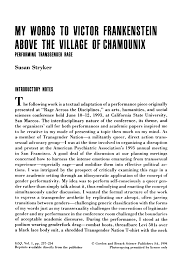
“My Words to Victor Frankenstein Above the Village of Chamounix” by Susan Stryker
Not a novel, but a striking nonfiction essay from the mid-’90s about Stryker’s kinship with Frankenstein’s creation, her trans identity, and how she uses her rage to create things of her own. Packed with wit, this personal essay on physicality and subjectivity provides a new way of looking at the concept of horror and monstrosity, and crucially challenges the binary demands of society. In using Shelley’s work as an empowering statement about the ownership of the self, Stryker’s essay recontextualises the equal freedoms and limitations that science can provide; how do you make your own body, how do you see it survive? Composed of varying sections, the essay is a stitched-together entity in itself that culminates in a powerful whole, and is a unique perspective that gives insight into the enduring relevance of Shelley’s FRANKENSTEIN. It is also freely available to read online!
Trigger warnings: transphobia, transphobic slurs, suicide



